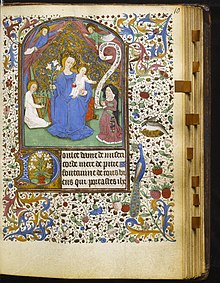Little Office of the Blessed Virgin Mary
The Little Office of the Blessed Virgin Mary, also known as Hours of the Virgin, is a
and other readings.All of the daily variation occurs in Matins. The text of the other offices remains the same from day to day in the Roman Rite and most other rites and uses. In the Roman Rite there are seasonal variations in Advent and Christmastide. The Gospel antiphons also change in Eastertide, although there are no other changes during that season. The Little Office was a core text of the medieval and early Reformation primers, a type of lay devotional.
History

The Little Office probably originated as a
The Little Office of the Blessed Virgin Mary is a variation of the Common of the Blessed Virgin Mary in the Liturgy of the Hours (Divine Office). It may have originally been put together to be prayed in connection with the Votive Masses of Our Lady on Saturday, which were written by Alcuin, the liturgical master of Charlemagne’s court.[2]
The Little Office did not come into general use before the tenth century.
Several early printed versions of the English uses of the Little Office survive in the Primers.In the twelfth century, the new foundation of the
Down to the Reformation it formed a central part of the primer and was customarily recited by devout laity,[1] by whom the practice was continued for long afterwards among Catholics.[1] After the revision of the Roman Breviary following the Council of Trent in 1545, the Little Office became an obligation for the ordained only on Saturdays but with the exception of Ember Saturdays, vigils, and the Saturdays of Lent.[3]
An English-only version appears appended to versions of Bishop Richard Challoner's "Garden of the Soul" in the eighteenth century, and with the restoration of the hierarchy in the 1860s, James Burns issued a Latin and English edition.
Minor revisions of the Office occurred in the twentieth century, most notably in 1910, as part of Pope
Following the Second Vatican Council
In 1963, following the Second Vatican Council, Pope Paul VI promulgated Sacrosanctum Concilium which stated: "Members of any institute dedicated to acquiring perfection who, according to their constitutions, are to recite any parts of the divine office are thereby performing the public prayer of the Church. They too perform the public prayer of the Church who, in virtue of their constitutions, recite any short office, provided this is drawn up after the pattern of the divine office and is duly approved."[4]
However, in the subsequent reforms following the Second Vatican Council, the Little Office was overshadowed by the revised Liturgy of the Hours. The Little Office was not officially revised after the Council, as many Congregations abandoned it in order to adopt the Liturgy of the Hours. According to Pope Paul VI's later Apostolic Letter Ecclesiae sanctae of 6 August 1966, "although Religious who recite a duly approved Little Office perform the public prayer of the Church (cf. Constitution Sacrosanctum Concilium, No. 98), it is nevertheless recommended to the institutes that in place of the Little Office they adopt the Divine Office either in part or in whole so that they may participate more intimately in the liturgical life of the Church".[5]
Nonetheless, several post-conciliar editions continue to be issued. The
At the same time, despite its decline among religious orders after the Council, the traditional Little Office in English and Latin continue to be printed. Carmel Books in the
Devotion to the Little Office
Saints throughout history who have prayed the Little Office regularly as part of their spiritual practice include:
Structure
See also
References
- ^ a b c d e
 One or more of the preceding sentences incorporates text from a publication now in the public domain: Toke, Leslie (1910). "Little Office of Our Lady". In Herbermann, Charles (ed.). Catholic Encyclopedia. Vol. 9. New York: Robert Appleton Company. Retrieved 1 October 2012.
One or more of the preceding sentences incorporates text from a publication now in the public domain: Toke, Leslie (1910). "Little Office of Our Lady". In Herbermann, Charles (ed.). Catholic Encyclopedia. Vol. 9. New York: Robert Appleton Company. Retrieved 1 October 2012.
- ^ a b "What is the Little Office", Marian Library, Dayton University, February 7, 2014
- ^ a b Lallou, William J., "The Little Office of Our Lady", The American Ecclesiastical Review, CUA Press, Washington, 1949, pp.100-110
- ^ Pope Paul VI. Sacrosanctum consilium, §98, December 4, 1963
- ^ Pope Paul VI. Ecclesiae Sanctae, §20, August 6, 1966, Libreria Editrice Vaticana
- ^ "Liturgical Celebration", The Carthusian way
- ^ Nevin, Thomas (2006). Therese of Lisieux: God's Gentle Warrior. New York: Oxford University Press. p. 243.
- ^ Siccardi, Cristina (2016). Pier Giorgio Frassati: A Hero for Our Times. San Francisco: Ignatius Press. p. 139.
- ^ Odell, Catherine (2017). Father Solanus Casey, Revised and Updated. Huntington: Our Sunday Visitor. p. 196.
